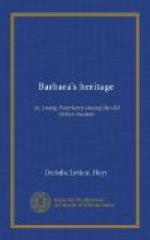But the chief man and artist they were now considering, was Michael Angelo; and the more they learned of him the more true it was, they thought, that he “filled all Florence.” They eagerly followed every step of his life from the time when, a young lad, he entered Ghirlandajo’s studio, until he was brought to Florence—a dead old man, concealed in a bale of merchandise, because the authorities refused permission to his friends to take his body from Rome—and was buried at midnight in Santa Croce.
They tried to imagine his life during the four years which he spent in the Medici Palace, now Palazzo Riccardi, under the patronage of Lorenzo the Magnificent, while he was studying with the same tremendous energy that marked all his life, going almost daily to the Brancacci Chapel to learn from Masaccio’s frescoes, and plunging into the subject of anatomy more like a devotee than a student.
They learned of his visit to Rome, where, before he was twenty-five years old, he sculptured the grand Pieta, or Dead Christ, which is still in St. Peter’s; and of his return to Florence, where he foresaw his David in the shapeless block of marble, and gained permission of the commissioners to hew it out,—the David which stood so long under the shadow of old gray Palazzo Vecchio, but is now in the Academy.
Then came the beginnings of his painting; and they saw the Holy Family of the Uffizi Gallery—his only finished easel picture—which possesses more of the qualities of sculpture than painting; and read about his competition with Leonardo da Vinci when he prepared the famous Cartoon of Pisa, now known to the world only by fragmentary copies.
Then Pope Julius II. summoned him back to Rome to begin work on that vast monument conceived for the commemoration of his own greatness, and destined never to be finished; and afterward gave him the commission to paint the ceiling of the Sistine Chapel of the Vatican.
Returning to Florence in an interval of this work, he sculptured the magnificent Medici monuments, to see which they often visited the Chapel of the Medici. At the same time, since the prospect of war had come to the beautiful city, he built those famous fortifications on San Miniato through whose gateway they entered whenever they visited this lovely hill, crowned by a noble old church and a quiet city of the dead.
They drove out to Settignano to visit the villa where he lived when a child, and which he owned all his life; and went to Casa Buonarroti in Florence, where his descendants have gathered together what they could of the great master’s sketches, early bas-reliefs, and manuscripts. Here they looked with reverence upon his handwriting, and little clay models moulded by his own fingers.
They talked of his affection for the noble Vittoria Colonna, and read the sonnets he wrote to her.
In short, they admired his great talents, loved his character, condoned his faults of temper, and felt the utmost sympathy with him in all the vicissitudes of his grand, inspiring life.




